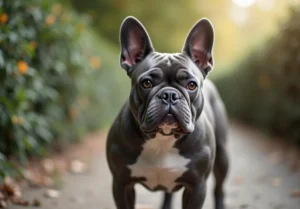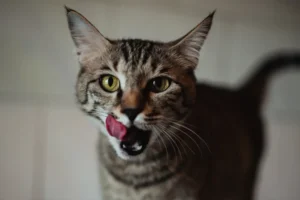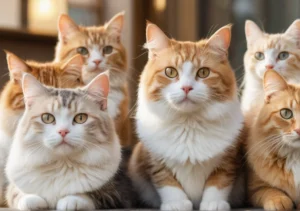Does it often leave you wondering why some cat breeds come with a hefty price tag? Let’s explore the reasons behind the expensive nature of certain cat breeds.
It’s a combination of factors that contribute to the high cost of cat breeds, from rarity to demand and specialized breeding practices. Let’s delve into why cat breeds are expensive and what makes them worth the investment.
Rarity Factor
Have you ever wondered why certain cat breeds come with a hefty price tag? One major factor contributing to the high cost of some cat breeds is their rarity. Just like rare gems or limited edition items, rare cat breeds are in high demand due to their uniqueness. Breeds that are hard to find or have a small population can be significantly more expensive than more common breeds.
For example, the Sokoke cat, known for its striking coat pattern and agile nature, is considered one of the rarest cat breeds in the world. Its scarcity drives up the price for those who want to own this unique feline companion. Similarly, the Peterbald cat, a hairless breed with a slender build, is not widely available and commands a higher price due to its rarity.
When a cat breed is scarce, breeders have limited breeding pairs to work with, making it challenging to meet the demand for these unique felines. As a result, the rareness of these breeds plays a significant role in their expensive price tags.
Breeding Practices
Another key aspect that influences the cost of cat breeds is breeding practices. The specialized breeding techniques used to produce specific traits or characteristics in a cat breed can drive up the overall cost of the kittens.
Breeders of Pedigree cats often invest a significant amount of time, effort, and resources into carefully planning and executing breeding programs to maintain the breed standard. This includes ensuring that the kittens meet specific physical traits, temperament, and health standards set by cat breed associations.
For example, breeding Scottish Fold cats with their distinctive folded ears requires careful selection of breeding pairs to avoid health issues associated with the gene mutation. This meticulous breeding process increases the cost of Scottish Fold kittens as breeders strive to produce healthy and genetically sound cats.
Furthermore, breeding practices for rare or unique cat breeds that involve importing cats from different parts of the world can add to the overall cost. The expenses associated with transportation, quarantine, and specialized care for imported cats contribute to the premium price of these exotic breeds.
In conclusion, the combination of rarity and specialized breeding practices are key factors that contribute to the expensive nature of certain cat breeds. By understanding these factors, you can gain insights into why some cat breeds come with a higher price tag and appreciate the dedication and effort that goes into producing these unique feline companions.
Health Concerns
Owning a particular cat breed can sometimes come with a hefty price tag due to specific health concerns that breed may be prone to. For example, breeds like the Scottish Fold or the Persian might have genetic predispositions to certain health issues, which can drive up costs associated with breeding, medical care, and testing to ensure the health of the kittens. To maintain the breed’s integrity and prevent potential health problems, responsible breeders invest a lot in ensuring the well-being of their cats, which in turn can make these breeds more expensive to acquire.
Demand and Popularity
The price of cat breeds can also be influenced by demand and popularity. Some breeds become trendy due to social media exposure or celebrity endorsements, leading to increased demand and subsequently higher prices. For example, breeds like the Maine Coon or the Bengal have gained popularity in recent years, making them more sought after and therefore more expensive to purchase. Additionally, limited availability of certain breeds can drive prices up further, as the laws of supply and demand come into play in the world of feline companions.
Additional Unique Insight or Angle: Breeding Standards
Another factor contributing to the expense of certain cat breeds is the adherence to strict breeding standards. Responsible breeders go to great lengths to ensure that their cats meet specific breed standards set by organizations like The International Cat Association (TICA) or the Cat Fanciers’ Association (CFA). This meticulous breeding process, aimed at preserving the characteristics and qualities of a particular breed, can increase the overall cost of acquiring a cat from that breed. The attention to detail and adherence to these standards often means that breeders have invested a significant amount of time, effort, and resources into producing high-quality kittens, thereby driving up the price.
Maintenance Costs
Owning a cat comes with various maintenance costs that can vary depending on the breed. Some breeds require more grooming, specialized diets, or regular medical check-ups, all of which can add up quickly. For example, breeds with long fur like the Persian or the Maine Coon may need daily brushing to prevent matting and tangles. This means investing in proper grooming tools and potentially professional grooming services, increasing your monthly expenses. Additionally, certain breeds are prone to specific health issues that might require regular vet visits or specialized treatments, further impacting your budget. It’s essential to research the specific needs of your chosen breed to budget accordingly and ensure you can provide the necessary care for your furry friend. Remember, a well-maintained cat is a happy and healthy cat!
Designer Breeds
Designer cat breeds have been gaining popularity in recent years, with unique features and personalities, leading to higher price tags. These breeds are often created by crossing two purebred cats to achieve a specific look or temperament, resulting in a limited supply that drives up the cost. Breeds like the Bengal, Scottish Fold, and Sphynx are examples of designer cats that are highly sought after for their distinct characteristics. When purchasing a designer breed, you’re not just paying for the cat’s appearance but also for the breeder’s expertise, time, and resources invested in creating and raising the kittens. Keep in mind that the initial cost of acquiring a designer breed is just the beginning, as ongoing care and maintenance for these unique cats can also be more expensive. Before splurging on a designer cat, consider if you’re willing and able to meet their specialized needs and provide a loving home for years to come.
Additional Insight : Investing in a purebred or designer cat can also mean higher insurance premiums, as these cats may be more prone to genetic health issues or accidents. Factor in potential insurance costs when budgeting for your new feline companion.
Training and Socialization
Training and socialization play a crucial role in the cost of certain cat breeds. Breeds that require specialized training programs or extensive socialization tend to be more expensive due to the time and effort involved in properly raising them. For example, breeds like the Bengal or the Scottish Fold may require specific handling techniques or behavioral training to ensure they grow into well-adjusted and happy pets.
When considering a particular cat breed, it’s essential to factor in the ongoing costs associated with training and socialization. Investing time and resources into proper training can ultimately save you money in the long run by preventing behavior issues or health problems down the line.
Remember, a well-trained and socialized cat is not only a joy to be around but also a reflection of responsible pet ownership. So, if you’re considering a breed that requires extra attention in these areas, be prepared to invest in professional training or behavioral consultations to give your feline companion the best start in life.
Rescue and Adoption Alternatives
If you have your heart set on a specific cat breed but find that purchasing one from a breeder is out of your budget, don’t lose hope! There are plenty of rescue and adoption alternatives available for those willing to put in the time and effort to find their perfect match.
Consider the following rescue and adoption alternatives: 1. Breed-specific rescues: Look for organizations dedicated to rescuing and rehoming a particular breed of cat. They often have a better understanding of the breed’s needs and can help you find a suitable match. 2. Local animal shelters: Many shelters have purebred cats available for adoption at a fraction of the cost of buying from a breeder. By adopting from a shelter, you’re not only saving money but also giving a deserving cat a second chance at a loving home. 3. Foster-to-adopt programs: Some rescue organizations offer foster-to-adopt programs where you can temporarily foster a cat before committing to adoption. This allows you to see if the breed is the right fit for your lifestyle before making a permanent commitment.
By exploring rescue and adoption alternatives, you can find the cat breed of your dreams without breaking the bank while also giving a deserving cat a loving forever home. Adopting a cat is a rewarding experience that brings joy to both you and your new feline friend.
Fun Facts
Unleash your inner cat enthusiast with these fun tidbits about expensive cat breeds:
- Did you know that the Ashera cat, one of the most expensive cat breeds, can cost up to a whopping $125,000? That’s more expensive than some luxury cars!
- The Peterbald cat breed, known for its unique hairless appearance, was actually created in Russia through selective breeding efforts. Talk about a rare find!
- The Savannah cat, a hybrid breed between a domestic cat and a serval, can reach prices of $20,000 or more. Its exotic look commands a premium price tag in the world of felines.
- The Bengal cat, a striking breed with a wild appearance reminiscent of its ancestor, the Asian leopard cat, can cost anywhere from $1,000 to $4,000. These beauties embody elegance and grace.
Next time you come across an expensive cat breed, remember these fascinating facts that make them truly one-of-a-kind!
Why Are Cat Breeds Expensive?
Understanding the factors behind the high prices of cat breeds can shed light on this seemingly costly world. One key reason for the expense is the rarity of certain breeds. Breeding unique and specialized cats takes time, effort, and resources, leading to higher costs for breeders and enthusiasts alike. Additionally, factors such as demand, location, and maintenance requirements can all contribute to the price tag of a particular cat breed. When looking to bring one of these exclusive felines into your home, it’s essential to consider the investment in care and resources that come along with their steep price.
Remember, the cost of a cat breed goes beyond the initial purchase price. Factor in ongoing expenses such as grooming, healthcare, and specialized diets to ensure your furry friend lives a happy and healthy life. By understanding the reasons behind the expense, you can make an informed decision when adding a unique cat breed to your family.
Alex, a passionate animal lover, has experience in training and understanding animal behavior. As a proud pet parent to two dogs and three cats, he founded AnimalReport.net to share insights from animal experts and expand his knowledge of the animal kingdom.




